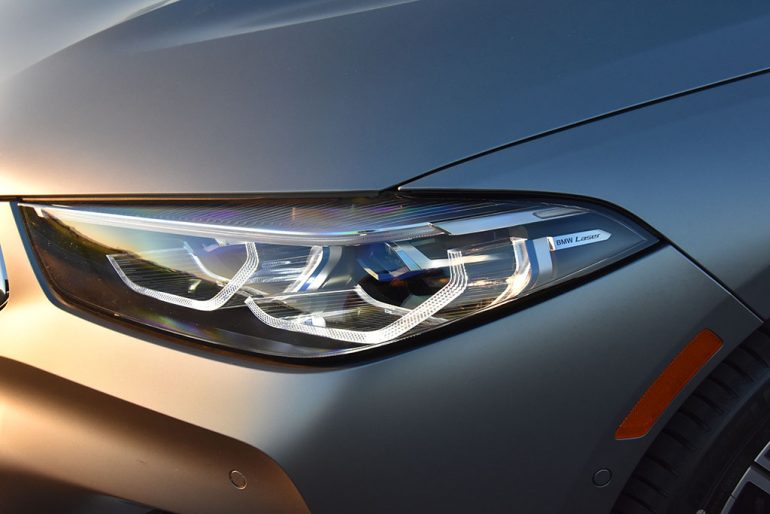
I’ve said it for many years, automakers need to really step it up when it comes to their headlights, and the US government needs to mandate and allow manufacturers to implement new headlight technology to make the roads safer at night.
It’s all easier said than done. Lighting up the way using modern-day automotive headlights is a huge mixed bag. We still have some vehicles that utilize older halogen lights, some that use HID (High Intensity Discharge) lights, and most new vehicles now using LED (light emitting diode) headlights. There are many different technologies coupled with auto-leveling systems, adaptive capability allowing headlights to turn or swivel with your steering input, and even headlights that utilize pixel LED matrix beams to adjust for a wider spread and the occasional start-up dance you find on new Mercedes-Benz and Audi vehicles. Even some automakers, such as BMW, have the option of Laser headlights, but are not enabled to use their full advanced adaptive capabilities here in the US because of current regulations. The headlight game is interesting, but you must wonder, is it all safe and beneficial, and do any of them currently reduce glare in the sight of oncoming traffic?
Recently, NBC broadcasted and published a compelling story and factual evidence that the United States is decades behind the rest of the developed world when it comes to headlight technologies on new vehicles. In fact, Greg Brannon, AAA’s director of automotive engineering and industry relations, said to NBC that “The standards have not been substantively updated since the ‘70s. Meanwhile, technology has marched on.”

Nighttime driving can be challenging for many, and the quality of your vehicle’s headlights are often a deciding factor of you making it safely to your destination or an unfortunate factor of blinding oncoming traffic. The use of new LED headlights in vehicles poses a new set of issues apart from what we consider older headlight technology of being inferior. Yes, halogen headlights are inferior in many ways, but use of newer LED headlights brings new issues, one primarily being the fact that they cause glare.
However, other countries that allow the adoption of new vehicle technology and have regulations put in place to mandate that vehicles have a certain level of headlight tech are ultimately safer at night because they don’t have the same “glaring” problem that we do here in the USA. The glaring issue lies with LED headlights having more of a blue-white color, which the human eye is more sensitive to, versus viewing the yellowish hue of halogen lights. Therefore, LED headlights should have methods of redirecting the light beam to focus more on the road than in the face of oncoming traffic drivers or beaming into someone’s rearview mirror. Simply put, your eye is slower to react to a bluish light than a yellow-tinted light, and that usually results in unwanted glare or in some cases, temporary blind spots.
John Bullough, program director at Mount Sinai’s Light and Health Research Center, said to NBC when referencing new LED headlights, “Our eyes are actually more sensitive to the bluer light that these lights can produce, compared to the yellow or light of the halogen lights.”
The interesting fact about headlight technology is that these “glaring” issues don’t have to be. There’s enough advanced automotive technology out there that can be equipped on all new cars to reduce or nearly eliminate unwanted glare from newer LED headlights. Moreover, too many vehicles in the US have misaligned headlights or lack the proper aiming and leveling technology, especially when they are equipped on taller vehicles like trucks and SUVs.

As many as 15 states in the US require annual and biennial passenger vehicle inspections, of which 10 of those states the inspections include a headlight check to assure that they are aimed correctly and are functioning properly.
Headlight alignment isn’t a difficult thing to perform on most vehicles. Some new vehicles have self-leveling headlights but still may require proper adjustments as a baseline for their computer leveling the sharp beam of both headlights. The IIHS (Insurance Institute for Highway Safety) and NHTSA (National Highway Traffic Safety Administration) have been vying to mandate headlight requirements along with asking federal regulators to add testing to its requirements.
“If there’s a single issue with the regulation that we discovered [by testing] that needs to be fixed, it’s this issue of aim,” said Matthew Brumbelow, a senior research engineer at the IIHS.
As the season changes and you get your next oil change or visit your vehicle service center, it would be a good idea to ask your service advisor or mechanic to check the alignment of your headlights. For those who are savvy enough, let this be a reminder to check the alignment and operation of your headlights, too, no matter what technology they use.
Until the government or regulators here in the US start to change the rules and regulations for headlights, we must do our part to help make our roads a safer place at night. Also, make sure you turn your headlights ON at night and not just allow your daytime running lights to serve as your primary light source – that’s really annoying and dangerous for everyone around you – even if you claim that you can still see the road!

Malcolm Hogan is the founder and editor of Automotive Addicts, a trusted voice in the automotive media world for over two decades. With 20+ years of hands-on experience covering the industry, Malcolm has built a reputation for delivering honest reviews, sharp insights, and in-depth coverage of everything from new car debuts to high-performance test drives. Passionate about the evolving car culture and staying ahead of the curve, Malcolm continues to lead Automotive Addicts as a go-to destination for enthusiasts and industry insiders alike.